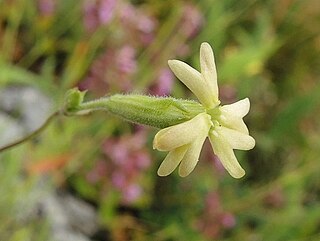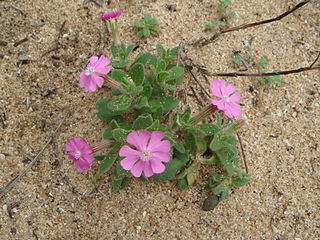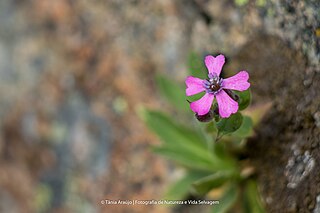
Silene is a genus of flowering plants in the family Caryophyllaceae. Containing nearly 900 species, it is the largest genus in the family. Common names include campion and catchfly. Many Silene species are widely distributed, particularly in the northern hemisphere.

Caryophyllaceae, commonly called the pink family or carnation family, is a family of flowering plants. It is included in the dicotyledon order Caryophyllales in the APG III system, alongside 33 other families, including Amaranthaceae, Cactaceae, and Polygonaceae. It is a large family, with 81 genera and about 2,625 known species.
Dioecy is a characteristic of a species, meaning that it has distinct individual organisms (unisexual) that produce male or female gametes, either directly or indirectly. Dioecious reproduction is biparental reproduction. Dioecy has costs, since only about half the population directly produces offspring. It is one method for excluding self-fertilization and promoting allogamy (outcrossing), and thus tends to reduce the expression of recessive deleterious mutations present in a population. Plants have several other methods of preventing self-fertilization including, for example, dichogamy, herkogamy, and self-incompatibility.

Silene acaulis, known as moss campion or cushion pink, is a small mountain-dwelling wildflower that is common all over the high arctic and tundra and in high mountains of Eurasia and North America. It is an evergreen perennial flowering plant in the carnation family Caryophyllaceae.

Silene vulgaris, the bladder campion or maidenstears, is a plant species of the genus Silene of the family Caryophyllaceae. It is native to Europe, where in some parts it is eaten, but is also widespread in North America, where it is a common wildflower in meadows, open woods, and fields.

Gynodioecy is a rare breeding system that is found in certain flowering plant species in which female and hermaphroditic plants coexist within a population. Gynodioecy is the evolutionary intermediate between hermaphroditism and dioecy.

Leaf window, also known as epidermal window, and fenestration. is a specialized leaf structure consisting of a translucent area through which light can enter the interior surfaces of the leaf where photosynthesis can occur. The translucent structure may include epidermal tissue, and in some succulent plants it consists of several cell layers of parenchyma, which may also function as water-storage tissue. It can appear as a large continuous patch, a variegated or reticulated region, or as numerous small spots. Is found in some succulent plants native to arid climates, allowing much of the plant to remain beneath the soil surface where it is protected from desiccation by winds and heat while optimizing light absorption. Many species featuring leaf windows are native to Southern Africa.

Silene is a flowering plant genus that has evolved a dioecious reproductive system. This is made possible through heteromorphic sex chromosomes expressed as XY. Silene recently evolved sex chromosomes 5-10 million years ago and are widely used by geneticists and biologists to study the mechanisms of sex determination since they are one of only 39 species across 14 families of angiosperm that possess sex-determining genes. Silene are studied because of their ability to produce offspring with a plethora of reproductive systems. The common inference drawn from such studies is that the sex of the offspring is determined by the Y chromosome.

Silene flavescens are flowering plants part of the genus Silene, family Caryophyllaceae. They are widely distributed and are found in the northern hemisphere. They are native to Hungary and the Balkan Peninsula. It is an herbaceous species belonging to the tribe Sileneae

Silene otites, called Spanish catchfly, is a species of flowering plant in the genus Silene, native to Europe and the Transcaucasus area, and introduced to Xinjiang in China. It varies its floral odors to attract mosquitoes and moths at night and flies and bees by day. It is dioecious, with separate male and female plants.
Gynomonoecy is defined as the presence of both female and hermaphrodite flowers on the same individual of a plant species. It is prevalent in Asteraceae but is poorly understood.
Silene tibetica is a species of plant which is a member of the family Caryophyllaceae. The species can be found in Tibet.

Silene banksia is a species of flowering plant in the family Caryophyllaceae. It is native to southeastern Siberia, most of China, and North Korea, and it has been introduced to Mongolia and Japan. The species goes by the common names Chinese lychnis and jian chun luo. It is a cultigen, domesticated in northeast Asia at some time on the distant past. No wild individuals are known.

Silene rubella is a species of flowering plant in the family Caryophyllaceae. In Italy the species goes by the common name silene rosseggiante.
Silene disticha is a species of flowering plant in the family Caryophyllaceae. The species is hermaphroditic and is native to Algeria, Morocco, Portugal, Spain, and Tunisia.

Silene littorea is a species of flowering plant in the family Caryophyllaceae. The species is an annual plant.

Weberocereus tunilla is an epiphytic cactus native to Costa Rica, Nicaragua and Panama. It is the type species of Weberocereus. Its flower emits an unpleasant musky smell after opening and is pollinated by bats.

Silene sedoides is a species of Silene. It is widely distributed across the Aegean Sea but one of its subspecies is endemic to Greece.

Silene acutifolia is a species of herb native to northwest Spain as well as central and northern Portugal. The species is polycarpic and usually grows in rocky environments.

Silene italica is a species of plant native to Southern Europe and parts of Asia. It is also introduced to parts of the United States and Northern Europe.

















